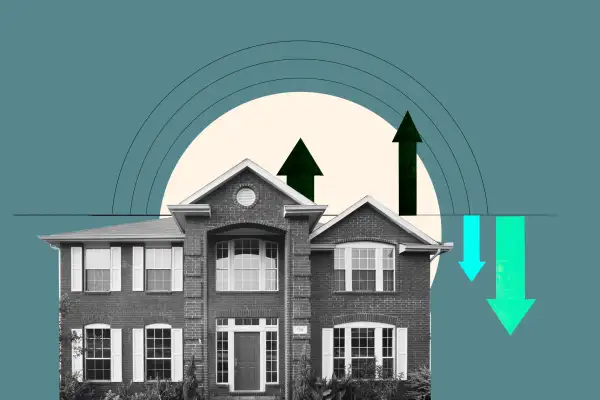Today's Mortgage Rates Slip Below 6% | April 15, 2022

The daily average rate for a 30-year fixed-rate mortgage moved below 6% today after four consecutive days above that threshold. The directions of rates for other loan types, including the 15-year fixed-rate mortgage and the 5/1 adjustable rate mortgage, were mixed. Nevertheless, rates are clearly moving away from the super-low levels of the past two-years.
- The latest rate on a 30-year fixed-rate mortgage is 5.854%. ⇓
- The latest rate on a 15-year fixed-rate mortgage is 5.181%. ⇑
- The latest rate on a 5/1 ARM is 4.158%. ⇓
- The latest rate on a 7/1 ARM is 4.314%. ⇓
- The latest rate on a 10/1 ARM is 4.39%. ⇓
Money's daily mortgage rates reflect what a borrower with a 20% down payment and a 700 credit score — roughly the national average score — might pay if he or she applied for a home loan right now. Each day's rates are based on the average rate 8,000 lenders offered to applicants the previous business day. Freddie Mac's weekly rates will generally be lower since they measure rates offered to borrowers with higher credit scores.
Looking for a loan? Check out Money's lists of the best mortgage lenders and best refinance lenders.
Today's 30-year fixed-rate mortgage rates
- The 30-year rate is 6.5%.
- That's a one-day decrease of 0.646 percentage points.
Most borrowers opt for a 30-year fixed-rate mortgage. The long payback time means your monthly payment will be relatively low, while the fixed interest rate means those payments won't change. It's not the most economical option in terms of total borrowing costs, however, because you'll be paying a higher interest rate for a longer time compared to a shorter-term loan.
Today's 15-year fixed-rate mortgage rates
- The 15-year rate is 5.181%.
- That's a one-day increase of 0.032 percentage points.
A 15-year fixed-rate mortgage will have lower overall costs compared to a 30-year loan of the same size. The interest rate is lower and you'll pay it for less time. The major caveat is that the monthly payments will be substantially higher since the loan has to be paid off faster, and may not fit your monthly budget.
Use a mortgage calculator to determine which option is best for you.
The latest rates on adjustable-rate mortgages
- The latest rate on a 5/1 ARM is 4.158%. ⇓
- The latest rate on a 7/1 ARM is 4.314%. ⇓
- The latest rate on a 10/1 ARM is 4.39%. ⇓
An adjustable-rate mortgage can be a good option if you don't plan on keeping the home long-term. There will be an initial fixed-rate period when the interest rate will be very low, then the rate will eventually become adjustable and reset periodically. For instance, a 5/1 ARM will have a fixed rate for five years before it starts resetting yearly. If you plan on keeping the home long-term, just remember that the rate could see a big increase once it starts adjusting and budget accordingly.
The latest VA, FHA and jumbo loan rates
The average rates for FHA, VA and jumbo loans are:
- The rate on a 30-year FHA mortgage is 5.538%. ⇑
- The rate on a 30-year VA mortgage is 5.579%. ⇑
- The rate on a 30-year jumbo mortgage is 4.809%. ⇔
The latest mortgage refinance rates
The average refinance rates for 30-year loans, 15-year loans and ARMs are:
- The refinance rate on a 30-year fixed-rate refinance is 6.024%. ⇓
- The refinance rate on a 15-year fixed-rate refinance is 5.098%. ⇓
- The refinance rate on a 5/1 ARM is 4.202%. ⇓
- The refinance rate on a 7/1 ARM is 4.358%. ⇓
- The refinance rate on a 10/1 ARM is 4.434%. ⇓
Where are mortgage rates heading this year?
Mortgage rates sank through 2020. Millions of homeowners responded to low mortgage rates by refinancing existing loans and taking out new ones. Many people bought homes they may not have been able to afford if rates were higher. In January 2021, rates briefly dropped to the lowest levels on record, but trended slightly higher through the rest of the year.
Looking ahead, experts believe interest rates will rise more in 2022, but also modestly. Factors that could influence rates include continued economic improvement and more gains in the labor market. The Federal Reserve has also begun tapering its purchase of mortgage-backed securities and raised the federal funds rate for the first time in March to combat rising inflation. The Fed has signaled six more hikes are likely this year.
While mortgage rates are likely to rise, experts say the increase won’t happen overnight and it won’t be a dramatic jump. Rates should stay near historically low levels through the first half of the year, rising slightly later in the year. Even with rising rates, it will still be a favorable time to finance a new home or refinance a mortgage.
Factors that influence mortgage rates include:
- The Federal Reserve. The Fed took swift action when the pandemic hit the United States in March of 2020. The Fed announced plans to keep money moving through the economy by dropping the short-term Federal Fund interest rate to between 0% and 0.25%, which is as low as they go. The central bank also pledged to buy mortgage-backed securities and treasuries, propping up the housing finance market but began cutting back those purchases in November.
- The 10-year Treasury note. Mortgage rates move in lockstep with the yields on the government’s 10-year Treasury note. Yields dropped below 1% for the first time in March 2020 and have been rising since then. On average, there is typically a 1.8 point “spread” between Treasury yields and benchmark mortgage rates.
- The broader economy. Unemployment rates and changes in gross domestic product are important indicators of the overall health of the economy. When employment and GDP growth are low, it means the economy is weak, which can push interest rates down. Thanks to the pandemic, unemployment levels reached all-time highs early last year and have not yet recovered. GDP also took a hit, and while it has bounced back somewhat, there is still a lot of room for improvement.
Tips for getting the lowest mortgage rate possible
There is no universal mortgage rate that all borrowers receive. Qualifying for the lowest mortgage rates takes a little bit of work and will depend on both personal financial factors and market conditions.
Check your credit score and credit report. Errors or other red flags may be dragging your credit score down. Borrowers with the highest credit scores are the ones who will get the best rates, so checking your credit report before you start the house-hunting process is key. Taking steps to fix errors will help you raise your score. If you have high credit card balances, paying them down can also provide a quick boost.
Save up money for a sizeable down payment. This will lower your loan-to-value ratio, which means how much of the home’s price the lender has to finance. A lower LTV usually translates to a lower mortgage rate. Lenders also like to see money that has been saved in an account for at least 60 days. It tells the lender you have the money to finance the home purchase.
Shop around for the best rate. Don’t settle for the first interest rate that a lender offers you. Check with at least three different lenders to see who offers the lowest interest. Also consider different types of lenders, such as credit unions and online lenders in addition to traditional banks.
Also, take time to find out about different loan types. While the 30-year fixed-rate mortgage is the most common type of mortgage, consider a shorter-term loan like a 15-year loan or an adjustable-rate mortgage. These types of loans often come with a lower rate than a conventional 30-year mortgage. Compare the costs of all to see which one best fits your needs and financial situation. Government loans — such as those backed by the Federal Housing Authority, the Department of Veterans Affairs and the Department of Agriculture — can be more affordable options for those who qualify.
Finally, lock in your rate. Locking your rate once you’ve found the right rate, loan product and lender will help guarantee your mortgage rate won’t increase before you close on the loan.
Our mortgage rate methodology
Money’s daily mortgage rates show the average rate offered by over 8,000 lenders across the United States the most recent business day rates are available. Today, we are showing rates for Thursday, April 14, 2022. Our rates reflect what a typical borrower with a 700 credit score might expect to pay for a home loan right now. These rates were offered to people putting 20% down and include discount points.
More from Money:
- Best Mortgage Lenders of 2022
- Mortgage Calculator by Money
- How to Get the Lowest Mortgage Rate: A Step-by-Step Guide
- How to Get Preapproved for a Mortgage: A Step-by-Step Guide for Homebuyers
- Is Now a Good Time to Refinance My Mortgage? A Decision-Making Guide
Rates are subject to change. All information provided here is accurate as of the publish date.

